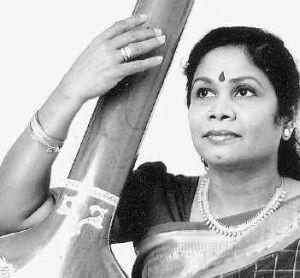
Complete live recording of a classical South Indian (Carnatic) vocal recital with announcements for each item
Items
1. Mangalavara Ganapate (Varnam) 05:14
Raga: Hamsadhvani; Tala: Adi; Composer: Tanjavoor S. Kalyanaraman
2. Sogasuga Mridanga Talamu (Kriti) 11:29
Raga: Sriranjani; Tala: Rupakam; Composer: Tyagaraja
3.Taye Tripura Sundari (Kriti) 07:05
Raga: Suddhasaveri; Tala: Khanda Chapu; Composer: Periyaswami Tooran
4. Minakshi Memudam (Kriti) 25:31
Raga: Purvikalyani (= Gamagakriya); Tala: Adi; Composer: Muttusvami Dikshitar
5. Shobhillu Saptasvara (Kriti) 05:17
Raga: Jaganmohini; Tala: Rupakam; Composer: Tyagaraja
6. Ninne Nammiti (Kriti) 35:26
Raga: Simhendramadhyamam; Tala: Misra Chapu; Composer: Mysore Vasudevachar
7. Raga Tanam Pallavi 24:40
Raga: Sankarabharanam and Ragamalika; Tala: KhandaTriputa
8. Bhavayami Gopalabala Sevitam (Padam) 04:55
Raga: Yamunakalyani; Tala: Khanda Chapu Composer: Annamacharya;
9.Tillana 05:33
Raga: Brindavani; Tala: Adi; Composer: Tanjavoor S. Kalyanaraman
10. Ni Nama Rupamulaku (Mangalam) 00:59
Raga: Saurashtram; Tala: Adi; Composer: Tyagaraja
(followed by Madhyamavati raga)
Place and date: Hitzacker (Germany), 27 May 2002
Listen to the full concert
Tips
- Please be patient and wait for the audio files to load in the above player
- Click the above Play button for continuous listening
- Click on any hyperlinks or the Forward/Backward buttons for repeated listening to any particular concert item
- Download and other options are seen on Archive.org >>
Performers
Bhushany Kalyanaraman – Vocal
Pakala Ramadas – Violin
T. R. Sundaresan – Mridangam, Kanjira, Morsing and Konnakkol
Katharina Bunzel – Tambura
About the main performer
SINGLE-MINDED devotion to Carnatic music — that sums up Bhushany Kalyanaraman. Hers is an extraordinary tale, spanning oceans. Born and brought up in Colombo, Sri Lanka, it was a typical Tamil household where her father used to ensure that everyone was awake at 5 a.m., reciting the Tiruvempavai. A renowned musician, her father had won the title “Sangita Bhushanam” from Annamalai University. All her sisters too sang well.
Love of Carnatic music brought Bhushany to Chennai, at 16,to stay and study music at the Government Music College. She went back to Sri Lanka, to teach music at a Jaffna college. The riots in 1982 brought her back to India, drawn by her deep admiration for her subsequent guru and husband, Tanjore S.Kalyanaraman, senior disciple of the legendary G.N.B. […]
A senior vocalist today, Bhushany has number of students both here and abroad, and many foreign students of Indian origin, who come to live with and learn from her. Many of her foreign-based students have had their formal arangetrams, proving her success as a teacher. […]
Grateful for everything that music has bestowed on her, she also wishes to do something for destitute women and children “to be able to reach out to people who do not have the luxury of music, people weighed down by pressing basic needs, to survive.” […]
Bhushany is a fortunate person — she has the best of both Sri Lanka and India, the best gained by besting life’s many odds
Source: Rupa Gopal in The Hindu (print edition), 7 March 2004 profiling “women who have made a career out of their passion”
Credits
Johann Wellendorf and Media Department, University Lueneburg (Germany); recording for the benefit of participants in its distance education course The Music of South India www.carnaticstudent.org
Information about the persons, items or topics
- Find song lyrics
- Research & Custom search engines
- The Oxford Illustrated Companion to South Indian Classical Music
- Suppliers of books & musical instruments
Learn & practice more
- A brief introduction to Carnatic music (with music examples and interactive map)
- Free “flow” exercises on this website
- Glossary (PDF)
- Introduction (values in the light of modernity)
- Video | Keeping tala with hand gestures: Adi (8 beats) & Misra chapu (7 beats)
- Voice culture and singing
- Why Carnatic Music Matters More Than Ever
- Worldcat.org book and journal search (including Open Access)
